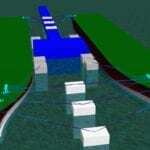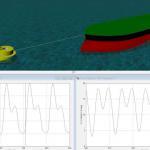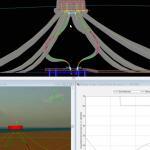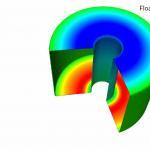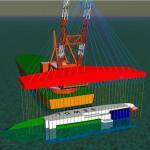DRILLING RISER, WELLHEAD & CONDUCTOR ANALYSIS METHODOLOY (Semi/Drillship)
Data Review and Design Basis
STA will receive data for each project from Company together with a scope of work specific to that project. STA then generates a task list and schedule for completion. Resources of engineers and software are assigned to the schedule. A design basis will be prepared with the following:
- The conductor and casing program
- The drilling vessel and riser data
- For missing data, a template will be provided to the client defining sample data to help gather additional information required.
- The units used will provided and client confirmation will be requested.
- Analysis methodology to be used for analysis will also be presented in the document.
Riser Joint Stack-up Modelling and Preliminary Analysis
The base case riser joint stack-up provided by Company will be used in STA Excel and OrcaFlex data files. The base case will be compared with available buoyant and slick joints available on the rig and an alternative optimum arrangement proposed if deemed necessary.
The riser configuration development is expected to be iterative and the flow chart and will follow the most recent API and DNV codes.

Example Riser Stack-up Configuration for Deepwater.

Typical Drilling Riser Analysis Procedure shown above.
Tension Requirement Assessment
Tension requirement will be determined using the following:
- Tension requirements will be determined as per API RP 16Q code.
- The internal fluid density considered for analysis will range from seawater (8.55 ppg) to maximum mud weight used.
- Measured mass and weight data will be used if available. Alternatively, this will be calculated based on pipe geometries of main and auxiliary (C&K, hydraulic and boost) lines.
- An example tension requirements chart is shown below.
Tension optimization analysis will be conducted for the riser as follows to help maximize riser operating envelopes for a given tension:
- Static analysis will be conducted with vessel offset (+ve and –ve) and without environmental loading
- Analysis is also conducted with vessel offset (+ve and –ve) and current loading to understand the riser response
- The responses considered along the length of the riser to ensure analysis correctness are :
- Riser and conductor stress
- Top tension
- Bending moment
- Flexible joint angle responses
- Stroke response
- Typically, based on upper and lower flexible joint responses for varying, tensions, a suitable top tension will be recommended for operations. This recommended tension will also be used for all subsequent analysis. Final minimum and maximum tensioning recommendations will be adjusted to satisfy the requirements of riser recoil analysis results, when applicable.

Example Tension Requirements with Mud Weight, shown above.

Example Flex Joint and Stroke Response for 300 kips Overpull at Base of LMRP, shown above.
VIV Fatigue Analysis (Currents)
VIV analysis is conducted using Shear7 and its automated links to OrcaFlex.
Modal analysis is conducted using the finite element model to determine the natural frequency response of the entire riser and conductor system along with soil properties. The soil properties will need to be adjusted to represent the Eigenvalue solutions for small displacement response of the conductor.
The long-term and extreme current data is used to determine susceptibility of the system to VIV. Where appropriate, the long-term fatigue life is evaluated by factoring the individual current profile fatigue life with probability of occurrence (Miner’s rule of damage addition).
The design SN curve for the drilling riser pipe as well as conductor & casing fatigue critical locations (welds & connectors) is considered for fatigue analysis.
The consequences of drilling riser VIV are not just riser fatigue; the vibrations also cause damage to the conductor. Riser joint inspections after riser retrieval can be used to manage risk of subsequent riser failure; however, fatigue damage in the conductor is more difficult to manage from this perspective.
In the presence of high surface currents with significant shear in the current profile, VIV results are often expected to be conservative. If VIV analysis indicates a likelihood of severe VIV fatigue damage, VIV suppression devices will be considered as a recommendation for risk mitigation. One such mitigation is the use of alternating slick and buoyant joints. A more well-established form of mitigation with proven industry track record (such as riser fairings, helical strakes etc.) that are better suited to counter severe anticipated VIV. With any type of mitigation, the recommendation will incorporate cost, operational, and practical considerations. For additional riser integrity management, the cost/benefit of field monitoring of riser motions, BOP motions, and conductor motions is considered to manage the risk of fatigue in the riser, the wellhead, and the conductor.
First Order (Wave) Fatigue Analysis
Wave fatigue analysis of the riser and conductor system is performed to determine fatigue damage due to wave induced vessel motion. The key considerations for this analysis are:
- The analysis is conducted using the time domain finite element software.
- The long-term wave scatter diagram given in the Metocean report is used to perform analysis for representative sea-states.
- The BOP on Wellhead analysis is included in the base scope of work. The key configurations utilized for the completion and intervention can also be considered upon client request.
Using both VIV and wave fatigue analysis, overall combined fatigue life is evaluated to determine riser operation durations. To assist in operations, a fatigue results presentation is provided as follows:
- Easy to use fatigue damage accumulated indicators as shown in Tables.

Example Wellhead and Conductor Fatigue Damage Accumulated During Drilling and Completion Campaigns shown in Table Above.
Riser Operating Envelope Analysis
Riser operating envelope analysis is performed to develop riser operating envelopes. The key analysis considerations are as follows:
- Analysis is conducted for varying mud weight, offsets, currents and wave conditions.
- Operating envelopes for use in current dominated environment conditions are shown below.
- Drilling and non-drilling operating limits are developed for use in wave dominated environment conditions. An example drilling operating envelope in wave dominated conditions is shown below.


Wellhead and Conductor Strength Analysis
The wellhead and conductor strength analysis is conducted to determine the acceptability of the system. The key considerations for the analysis are:
- The riser and conductor model is a connected and comprehensive finite element model. A global riser analysis performed for operating envelopes also provides the response for use for the wellhead and conductor strength analysis.
- The conductor and wellhead loading response is compared against the capacities.
- The main conductor pipe stress response is also assessed for acceptable response. As the conductor system is the main barrier to the well, the stress levels even in accidental/abnormal conditions should never exceed yield.
- The design specifics of the wellhead system (rigid lock down or otherwise) is considered for the analysis to appropriately capture the conductor system response.
- An example wellhead and conductor analysis findings are shown in the figure below.

Drift-Off/Drive-Off Analysis
Drift-off/drive-off analysis is conducted for DP to help determine the limits at which the emergency disconnect or deadman sequence will need to be activated. The key considerations for this analysis are:
- Time domain analysis is performed using equations of motion for the vessel and riser connected
- Riser restoring forces are also considered for analysis
- Fully coupled analysis is undertaken
- The drive-off and drift-off analysis are similar from riser response point of view. The difference in vessel motion is accounted for.
- The reaction time preferred by the client and drilling contractor is used for the analysis.
- An example drift-off watch circle limits is provided below.

Riser Hang-Off Analysis
Hang-off analysis is conducted to help determine acceptable response of the riser in the event of a planned or emergency disconnects. The key considerations for hang-off are given below:
- The hang-off configurations considered for analysis are project based.
- The two typical configurations are hard hang-off and soft hang-off.
- Any other customized hang-off configuration can also be modelled appropriately.
- Installation with and without BOP is considered.
- Riser axial dynamics are studied and mitigation options (if required) are recommended. The axial natural periods are also identified to help understand the riser response if vessel wave loading and/or riser VIV loading is experienced near the riser axial natural period(s).
- When subjected to strong currents, to help attain acceptable strength and/or fatigue response and/or minimize damage, drifting downstream (in direction of current) may be required. Note that downstream drifting may not always be feasible if there are constraints such as existing facilities or geophysical constraints such as escarpments which need to be identified.
- Example hang-off results are shown below.
- An example axial natural periods are also given in the table below.


Example Riser Axial Natural Periods (in seconds) shown in Table above.
Riser Recoil Shock Analysis
Riser recoil shock analysis is typically performed for dynamically positioned vessels to determine or confirm the recoil system response for emergency disconnect. The key considerations for the recoil analysis are:
- The riser recommended tension and tensioning system response should be such that:
- The LMRP should be lifted clear of the BOP/Wellhead system
- Minimize impact caused by the telescopic joint stroking at high speed
- Minimize rope slack caused by the riser moving faster than the tensioners
- The recoil analysis is modelled with OrcaFlex in 3-D in the time domain with a simplified model of the tensioners and control system, including stiffness, damping and control delays that capture the primary properties of the anti-recoil control system. The key aspects of the model are:
- The recoil analysis will model the riser with a spring-mass system using as many nodes as necessary with axial degrees of freedom.
- Hydrodynamic drag is modeled both outside and inside the riser. The simulations also include a small amount of material damping.
- The mud column is also modelled appropriately
- The recoil analysis typically models four tensioners with each representing one quarter of the effects of the total number of tensioners in the system.
- The analysis also considers each important section of the tensioner system, i.e. blind side cylinder pressure, rod side cylinder pressure, low pressure (LP) accumulator pressure, high pressure (HP) accumulator pressure, air pressure vessel (APV), recoil valve, HP air flow, HP fluid flow, and LP fluid flow.
- In an emergency disconnect event (Drift-off) the vessel offsets from the well and rotates (Yaw). The vessel heave response is influenced by the vessel heading and will be taken into consideration.
- Recoil will be conducted for various wave cycles to determine representative loads by accounting for the uncertainty of vessel motion time phase at the time of disconnect. The recoil tensions are calculated based on significant vessel heave amplitude corresponding to vessel heave motion in applicable significant wave height and peak period for the vessel heading at disconnect position.
- Recoil control parameters may be varied based on environmental conditions if required to get acceptable shock response in various conditions.
Example results from an emergency disconnect simulation are shown below, for a selected wave height, period and heading, with an associated current profile, in approximately 3000m water depth.


In summary, the recoil shock analysis is used to determine the minimum and maximum tensions that result from simulating the riser disconnect scenario. In this scenario, the minimum and maximum tensions are determined to maintain a recoil that lifts the LMRP off the BOP with no follow-up contact, avoids impact in the drill floor due to collapse of the telescopic joint, and avoids slack and subsequent re-tensioning in the riser tensioner lines. This riser response can be controlled by adjusting riser recoil system “settings”. The term “settings” is used here as a general term to cover the large variation in the types of recoil systems that exist in the worldwide DP fleet.
An example chart showing recommended tensioner settings is shown below.

Riser Installation/Retrieval Analysis
Riser installation/retrieval analysis is conducted to help determine the limiting conditions for installation. The key considerations for this analysis are:
- Varying installation depths are considered as required.
- Diverter housing and vessel moonpool contact are considered for analysis.
- Trim angles may be recommended to maintain optimum clearance in current dominated conditions.
- An example installation envelope is shown below.

Vessel Transit Analysis
Vessel transit analysis is conducted to help move between wells in the proximity in the same or adjacent fields. Also, “drift-running” is conducted in high currents as part of a planned operation to manage riser deployment operations in high currents. The key considerations for the vessel transit analysis are:
- The vessel transit analysis is performed with the proposed riser hang-off (typically hard hang-off) condition.
- Strength analysis is performed for the appropriate scenarios and recommendations are provided.
- Wave fatigue analysis is performed to help identify any limitations for transit.
- VIV fatigue analysis is performed to assess impact of VIV on the disconnected riser. The maximum velocity to help minimize VIV is established as a limitation for transit speed.
- Vessel downstream transit in the same direction as currents may also be required as a planned operation to conduct deployment in high currents (e.g. experiences in eddy currents in GoM, Trinidad, Brazil).
- To help riser deployment operations in high current events, drift running process can be utilized. The general analysis procedure is outlined below:
- Vessel starts up current at a certain distance and then drift towards to well as the riser is run/installed
- Drift speeds will be defined to keep riser off the side of the diverter housing. The riser also experiences relatively lesser stress levels.
- This simulation can help guide the operations on how far up-current to start drift-running.
- STA engineers possess experience in GoM, Trinidad and Brazil for the drift-running operations.
Conductor Length Assessment
Conductor length required for a given drilling campaign is based on the field specific geotechnical conditions, conductor installation method and the drilling program used. The key aspects considered for this analysis are:
- The conductor installation method will be considered for determining the axial resistance developed
- Drilled and cemented conductor has good axial resistance
- Jetted conductor will start with low axial resistance and will gain strength with time. The weight on bit during the last setting stages is particularly important to help develop higher axial resistances. Reciprocation is not recommended in the last installation stage.
- Casing if cemented will help gain significant strength for further load-out steps
- The conductor system loads based on the drilling program is considered for each installation stage to determine if the system axial resistance is acceptable
- The conductor length suitability is assessed. An example load and resistance chart is shown below.
- In the event the conductor length is unacceptable, a review of drilling procedure/methodologies for jetted conductor and/or soil properties is made. If the reviews are inconclusive, the increase in conductor length will be proposed.

Sensitivity Analysis
The riser and conductor system analysis results are evaluated utilizing sensitivity analysis. . A Robustness Assessment Study is used to guide this sensitivity analysis. This robustness assessment includes an intentional effort to confirm quality data on site conditions and system configuration and procedures, along with a hazard identification process conducted before the start of the analysis. Examples of sensitivity analyses that may be conducted are:
Examples of where sensitivity analysis performed include:
- Metocean conditions
- Environmental loading uncertainty
- Wellhead stickup
- Wellhead inclination
- Uncertainty in TOC elevations (cement shortfall)
- Soil strength and stiffness model
- Weld and connector details, including strength and fatigue limitations
- Conductor or casing (grade, wall thickness, weight etc.)
Sensitivity analysis is a quick way to understand the impact of certain parameters prior to or (sometimes) rather than undertaking full comprehensive analysis and thus saving time and effort for all parties. This also provides an indication of the need for risk mitigations.
Robustness Assessment
The riser and conductor system in DP, moored, and jack-up rigs is assessed for robustness using the framework provided in a draft SNAME document being published as “Robustness of Floating Production Systems – Definition and Framework”. The assessment recognizes that robustness exists in the system and reflects its resistance to the initiation and progression of hazardous events. When subject to perturbations (sensitivities as discussed in Section 2.15), a robust system should not cascade out of control or experience disproportionate responses, but rather it should maintain essential minimum features.
This calls for the robustness assessment for each rig type to use a hazard identification process to assess the riser, conductor, and the system configuration, along with the relevant operational procedures. The HAZID is driven by the site conditions, particularly the soil conditions and the seasonal metocean conditions. With hazards identified, the operations are discussed with the client to understand the barriers in place to prevent hazardous events.
The robustness assessment involves an intentional, upfront effort to clarify site details and system/procedures with the client. It also provides insight on which parts of the work scope require more attention than others and guides analysts in determining sensitivity cases.
The assessment also provides an indication of when risk management is needed. For example, vortex suppression devices are a means for mitigating riser vibration that would otherwise adversely affect both the riser and the conductor system. As another example, vibration monitoring using sensors on the riser and BOP is a means for managing the risk of riser and conductor failure by gathering data that can be processed to better understand accumulated fatigue damage. Monitoring can also be used to determine the relative motions of the jack-up and an adjacent platform.
A robustness report is prepared for each type of rig/site analysis: DP rig, moored rig, jack-up rig. Each report contains a summary of the provided site soil data, the seasonal metocean data, the system configuration, and relevant operational procedures. Key clarifications resulting from this robustness scope are described. Activities and results of the 3-hr HAZID meeting are summarized. The level of detail varies with the complexity of the rig/site analysis, i.e., jack-up rig, moored rig, DP rig.
 Example Riser Stack-up Configuration for Deepwater.
Example Riser Stack-up Configuration for Deepwater.
 Typical Drilling Riser Analysis Procedure shown above.
Typical Drilling Riser Analysis Procedure shown above.
 Example Tension Requirements with Mud Weight, shown above.
Example Tension Requirements with Mud Weight, shown above.
 Example Flex Joint and Stroke Response for 300 kips Overpull at Base of LMRP, shown above.
Example Flex Joint and Stroke Response for 300 kips Overpull at Base of LMRP, shown above.
 Example Wellhead and Conductor Fatigue Damage Accumulated During Drilling and Completion Campaigns shown in Table Above.
Example Wellhead and Conductor Fatigue Damage Accumulated During Drilling and Completion Campaigns shown in Table Above.





 Example Riser Axial Natural Periods (in seconds) shown in Table above.
Example Riser Axial Natural Periods (in seconds) shown in Table above.

 In summary, the recoil shock analysis is used to determine the minimum and maximum tensions that result from simulating the riser disconnect scenario. In this scenario, the minimum and maximum tensions are determined to maintain a recoil that lifts the LMRP off the BOP with no follow-up contact, avoids impact in the drill floor due to collapse of the telescopic joint, and avoids slack and subsequent re-tensioning in the riser tensioner lines. This riser response can be controlled by adjusting riser recoil system “settings”. The term “settings” is used here as a general term to cover the large variation in the types of recoil systems that exist in the worldwide DP fleet.
An example chart showing recommended tensioner settings is shown below.
In summary, the recoil shock analysis is used to determine the minimum and maximum tensions that result from simulating the riser disconnect scenario. In this scenario, the minimum and maximum tensions are determined to maintain a recoil that lifts the LMRP off the BOP with no follow-up contact, avoids impact in the drill floor due to collapse of the telescopic joint, and avoids slack and subsequent re-tensioning in the riser tensioner lines. This riser response can be controlled by adjusting riser recoil system “settings”. The term “settings” is used here as a general term to cover the large variation in the types of recoil systems that exist in the worldwide DP fleet.
An example chart showing recommended tensioner settings is shown below.






